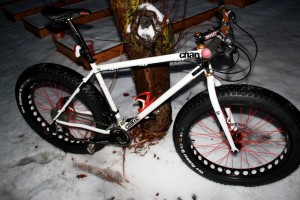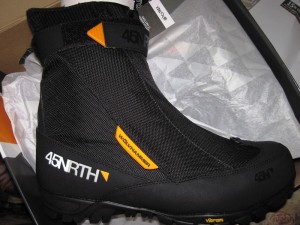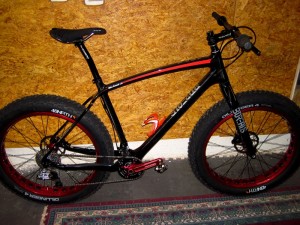 |
| Charge Cooker Maxi |
As luck would have it, last year was a banner snow year. We had the luxury of spending much of the winter in Western Maine where the snowmobile trails were abundant with access literally just down the street. We quickly grew to love the adventure of being out in the frigid winter nights with nary another sole in sight. We loved it so much that we rode literally every day last winter and spent over 100 hours on the bikes exploring over a thousand miles. One thing that became quickly clear was that when riding in the dead of winter, at night, in a northern climate, normal cycling clothing is inadequate. As a long time year round cyclist I'm used to riding in the cold weather. That said, cold weather riding in MA was usually in the upper teens at a minimum. Now imagine starting your ride in falling temperatures that start out at ten degrees colder than that. We very frequently rode in the single digits and did ride that never made it above zero.
 |
| 45NRTH Wolvhammer SPD |
On the feet, we used winter SPD cycling shoes with neoprene over boots. These worked pretty well, for a certain length of time and to a certain temperature level. Below about 15 degrees you only had a couple of hours before your feet would get cold from the moisture buildup. Chemical warmers helped stave off the cold as well so we often used them. This year, we have gone to the 45NRTH Wolvhammer SPD winter boots (which run small IMHO so I ordered two sizes bigger than normal). Luckily Chris was able to get some into the shop for us before they sold out for the season. They are the top end for warmth when it comes to SPD compatible cycling boots. We are looking very forward to using them. In terms of other clothing, we were fans of Nordic wind-front ski pants from Salomon with suspenders and bib shorts with leg warmer underneath rather than cycling tights. The nice thing about the pants was that the cuff went over the top of boot, which helped keep the warmth in and from escaping. In turn, I felt that my feet stayed warmer as well as my legs. Up top I used a myriad of different layers and materials. In the super cold we wore down sweaters outside with a long sleeve wicking base and a breathable thermal layering mid. When it was warmer we went a wind-vest over a long sleeve wicking base and a heavy breathable thermal layering mid. Also, whenever we went on longer rides we went prepared for the worst. This meant carrying a hooded packable down jacket, a thick winter hat and/or balaclava and extra mittens. If something went wrong when you were even a few miles out it takes no time at all to go from hot and sweaty to hypothermic. Where we often rode, there was no cell reception so we were on our own.
 |
| Borealis Yampa X-0/X-9 |
One other thing to consider is hydration. When it is below freezing, keeping your drink from freezing is a challenge. Clearly bottles don't work. The best luck that we have had is to use a minimalist Camelback worn under your outerwear, such that your body heat keeps it from freezing. Obviously, the hose needs to stay inside as well less it freeze and render the liquid somewhat useless for all intents and purposes.
Oh, I almost forgot. We also upgraded the bikes as well. We had so much fun last season that we jumped in with both feet, convincing Chris and the Bikeway Source to become the areas only Borealis Fat Bikes dealer. We bought a pair of the X-0/X-9 Yampa, a full carbon-fiber frameset with a very respectable parts spec. We opted for a 2x10 with double front chainrings for the range they offered. We ride some very diverse trails that have some incredibly steep sections that require low end, steady torque to maintain traction. On the same ride there are often long, fast downhill sections where I feared an adequately low one-by would spin out. My guess is that the weight saving alone, nearly ten pounds, is going to make the bikes feel like they can fly.
As you can imagine, we are very much looking forward to the winter months. If you are thinking about getting into fat biking, stop by the shop and see Chris. He usually has some bikes sitting on the floor, though this time of year, they are going out the door quickly.
No comments:
Post a Comment